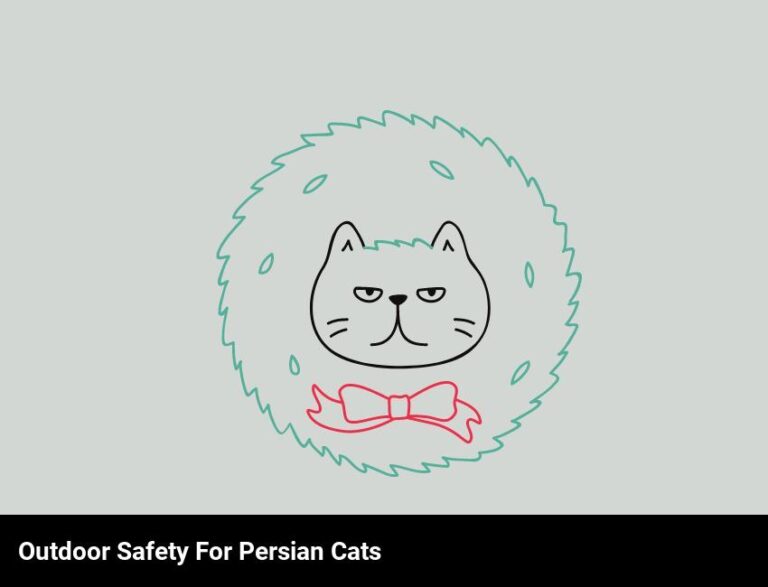Learn About Common Persian Cat Diseases
Persian cats are prone to some common health issues, including respiratory issues, eye infections, and hip dysplasia. It is important to stay informed about Persian cat diseases, so you can be prepared to help your furry friend if they become ill.
As a proud owner of a fluffy, lovable Persian cat, I understand the importance of keeping them healthy. But as much as we wish for our cats to stay healthy, it is important to be aware of common Persian cat diseases, so we can recognize the symptoms and provide them with the best possible care. In this blog, I will be exploring the various illnesses that our beloved cats might be susceptible to, how to spot the signs, how to prevent them, and how to provide the best care for our fur-babies.
Whether your Persian cat is already showing signs of illness or you want to be on the lookout for potential ailments, this blog will provide you with all the information you need to know. I will discuss the most common Persian cat diseases, the signs and symptoms to watch out for, the risk factors that increase the chances of illnesses, the treatment options, and the long-term effects. Finally, I will also provide the best ways to care for your Persian cat to keep it healthy and happy.
What are the most common persian cat diseases?
If you have a Persian cat, it’s important to know the most common diseases they can encounter. Fortunately, the majority of these illnesses can be prevented with proper care and nutrition. Here are some of the most common Persian cat diseases you should be aware of:
Feline Asthma: Feline asthma is a respiratory disorder that affects the airways of cats. Persian cats are more prone to developing this condition due to their brachycephalic head structure. Possible signs of feline asthma include wheezing, coughing, and difficulty breathing.
Feline Infectious Peritonitis: Feline infectious peritonitis (FIP) is an infectious disease caused by the feline coronavirus. Persian cats are at higher risk of developing FIP due to their compromised immune systems. Symptoms of FIP can vary, but generally include fever, loss of appetite, and weight loss.
Urolithiasis: Urolithiasis, or bladder stones, is a common issue that Persian cats can experience. The stones can form in the bladder or the urinary tract, and can cause pain, straining to urinate, and bloody urine. To prevent bladder stones, make sure your Persian cat is getting proper nutrition and plenty of water.
Feline Hyperthyroidism: Feline hyperthyroidism is a condition caused by an overactive thyroid gland. Symptoms include weight loss, increased appetite, and restlessness. Persian cats are more likely to develop this condition due to their genetic predisposition.
Eye Problems: Persian cats are prone to developing eye problems due to their flat faces and protruding eyes. Common eye issues include corneal ulcers, tear duct problems, and eyelid abnormalities. To prevent these issues, be sure to keep your Persian cat’s eyes clean and have regular checkups with your vet.
By being aware of the most common Persian cat diseases, you can help keep your cat healthy and happy. With proper care and nutrition, you can ensure that your Persian cat is living a long and healthy life.
How can you tell if your persian cat has a disease?
Are you worried your Persian cat might have a disease? The good news is there are some tell-tale signs that can help you figure out if your cat is unwell.
First, keep an eye on your cat’s behaviour. If your cat is usually outgoing but has become withdrawn or is sleeping more than usual, it might be a sign of illness. Changes in eating habits, such as eating less or more than usual, can also be a sign of illness.
Next, check your cat for any physical changes. Does your cat have any lumps or bumps, or do its eyes look red and itchy? Have you noticed any discharges from its ears or eyes? These can all be indications of a problem.
Finally, take your cat to the vet for a check-up. The vet can give your cat a full physical exam, as well as check its blood and urine for any signs of disease. They may also recommend diagnostic tests, such as X-rays or ultrasound, to look for any underlying issues.
By taking the time to look out for any signs of illness in your Persian cat, you can help ensure your furry friend stays healthy and happy. And if you ever suspect your cat might have a disease, don’t hesitate to take them to the vet for a check-up.
What are the signs and symptoms of typical persian cat diseases?
If you own a Persian cat, you want to be aware of common diseases that may affect them. Here are some signs and symptoms to look out for.
If your Persian cat is exhibiting any of the following symptoms, it could be a sign of a serious illness: vomiting, diarrhea, anorexia, weight loss, lethargy, excessive drinking and urination, and coughing. If you notice any of these signs, it’s important to take your cat to the vet right away.
Cats are particularly vulnerable to upper respiratory infections, which is why it’s important to keep their environment clean and their vaccinations up to date. Symptoms of a respiratory infection include sneezing, runny eyes and nose, and coughing. If you notice any of these signs, it’s important to take your cat to the vet right away.
Feline infectious peritonitis (FIP) is a viral infection that is particularly dangerous for Persian cats. Symptoms of FIP can include fever, loss of appetite, weight loss, and abdominal swelling. If your Persian cat is exhibiting any of these symptoms, it’s important to take them to the vet right away.
Finally, Persian cats are especially prone to dental disease. This can lead to pain and discomfort, as well as difficulty eating. If you notice your cat having difficulty eating, it’s important to take them to the vet right away.
If you own a Persian cat, it’s important to be aware of the common diseases they may be susceptible to. Be sure to watch out for any of the symptoms outlined above and take your cat to the vet right away if any are present.
How can you help prevent persian cat diseases?
You can help prevent Persian cat diseases by following some simple steps. First, keep your cat’s vaccinations up to date. Vaccines protect your cat from catching certain diseases, so it’s important to make sure your pet is protected. Secondly, make sure your pet has regular checkups. Taking your cat to the vet for regular checkups can help you spot any potential health problems early on.
Thirdly, keep your cat indoors. Outdoor cats are more exposed to illnesses, so keeping your cat indoors is the best way to keep it healthy. Fourth, feed your cat a balanced diet. A balanced diet will provide your cat with all the nutrients it needs to stay healthy. Finally, make sure your cat gets plenty of exercise. Exercise helps keep cats agile and strong, which can help prevent illnesses.
By following these simple steps, you can help protect your Persian cat from diseases. Keeping your cat healthy is important, so make sure you take the necessary steps to keep your pet safe.
What are the risk factors that increase the chances of persian cat diseases?
Owning a Persian cat can bring a lot of joy, but it’s important to be aware of the diseases they can suffer from so you can keep your cat healthy. Knowing the risk factors that increase the chances of Persian cat diseases can help you understand how to protect your pet.
There are several things that can increase the risk of Persian cat diseases. The first is age. Older cats are more prone to developing chronic health issues than younger cats. This means that if your Persian cat is over the age of 10, they may be more at risk of developing certain diseases.
Another risk factor is breed. Persian cats have a unique fur coat, which makes them prone to several skin conditions and eye infections. This means that the breed itself can put a cat at higher risk of developing certain diseases.
Additionally, Persian cats tend to be a bit overweight, which can also increase their chances of developing certain health issues. Being overweight can put extra stress on the body, leading to problems like diabetes and heart disease. If your Persian cat is overweight, it’s important to work with your vet to create a health plan to help them reach a healthy weight.
Finally, genetic factors can also increase the chances of Persian cat diseases. If your cat has a family history of certain chronic health issues, they may be more likely to develop them as well. This is why it’s important to get your Persian cat checked out by a vet on a regular basis, so any potential health issues can be caught early.
Being aware of the risk factors that increase the chances of Persian cat diseases can help you protect your pet and keep them healthy. With the right preventative measures in place, you can ensure your Persian cat stays healthy and happy.
What are the treatment options for persian cat diseases?
When it comes to Persian cat diseases, it’s important to know what treatment options are available. Fortunately, there are many treatments available for common Persian cat diseases.
For starters, if your Persian cat has a skin condition, then a vet may recommend topical medications such as corticosteroids to reduce inflammation and itching. Additionally, if the skin condition is due to an infection, then antibiotics may be prescribed.
If your Persian cat has an eye condition, such as conjunctivitis, then your vet may recommend a medicated eye drop or ointment. Additionally, if your cat is suffering from an ear infection, then medicated ear drops may be prescribed.
If your Persian cat is suffering from an upper respiratory infection, then your vet may recommend antibiotics, in addition to supportive care such as increased humidity and increased fluids. Additionally, if your cat has a lower urinary tract infection, then your vet may prescribe antibiotics.
Finally, if your Persian cat is suffering from a heart condition, then your vet may prescribe medications to reduce blood pressure, control arrhythmia, or treat congestive heart failure.
Overall, there are many treatment options available for common Persian cat diseases. It’s important to work with your vet to determine the best course of action for your cat. With the right treatment plan, your cat can enjoy a long and healthy life.
What are the long-term effects of persian cat diseases?
If you own a Persian cat, you should absolutely be aware of the common diseases associated with these beautiful felines. While the short-term effects of many of these diseases can be managed, the long-term effects can be devastating for your pet and your pocketbook. Here’s what you need to know about the long-term effects of Persian cat diseases.
The most serious long-term effects of Persian cat diseases include increased risk of infection, impaired organ function, and even death. For instance, if your cat suffers from Feline Infectious Peritonitis (FIP), a viral disease, it can cause liver damage and even death. If your cat is treated for FIP, they may still experience long-term complications such as impaired renal function. Similarly, if your cat has heart disease, the long-term effects can be severe, and may include difficulty breathing, weight loss, and even organ failure.
Other long-term effects of Persian cat diseases include chronic pain, malnourishment, and depression. These diseases can cause your cat to experience pain and discomfort, which can reduce their quality of life. Additionally, malnourishment can occur if your cat’s illness prevents them from eating enough or absorbing nutrients. Finally, depression can occur if your cat’s quality of life is significantly impacted by their illness.
It’s important to be aware of the long-term effects of Persian cat diseases so that you can protect your beloved pet. The best thing you can do is to bring your cat to the vet for regular check-ups, and to watch for signs of illness. If you notice anything out of the ordinary, be sure to have your cat checked out right away. Early diagnosis and treatment can help to prevent serious long-term effects and even death.
What are the best ways to care for your persian cat to keep it healthy?
Looking for the best ways to take care of your Persian cat? You’ve come to the right place! Persian cats are adorable and lovable, but they need special care to stay healthy. Here are a few tips to help keep your Persian cat happy and healthy:
- Grooming: Persian cats have long, luxurious coats, which require frequent brushing and combing to remain healthy and free of tangles and mats. In addition, a regular bath will help keep your cat’s coat clean and looking its best.
- Diet: Persian cats need a balanced diet that includes proteins, carbohydrates, and healthy fats. Avoid giving them table scraps or canned food that is high in sodium.
- Exercise: Exercise is an important part of keeping your Persian cat healthy. Make sure to provide your cat with toys and scratching posts to keep them active.
- Veterinary Care: Regular visits to the vet are essential for your cat’s health. Make sure to keep up to date with vaccinations, parasite prevention, and health check ups.
These tips will help keep your Persian cat healthy and happy for years to come. With the right care, your Persian cat will be a loyal and loving companion for a lifetime.

Frequently Asked Questions
What are some signs to look out for that could indicate a persian cat is sick?
When looking out for signs of illness in Persian cats, some of the most common signs include a lack of appetite, weight loss, excessive licking and grooming, bad breath, vomiting, diarrhea, coughing, sneezing, and difficulty breathing. If your Persian cat has any of these symptoms, it is important to contact your veterinarian right away.
Are there any special diets or supplements that help persian cats stay healthy?
Yes, there are some special diets and supplements that can help keep your Persian cat healthy. To ensure your cat gets the right nutrition, talk to your veterinarian about choosing the right food and supplements. It’s also important to keep your cat’s environment clean and free of allergens, as well as provide regular exercise and vet check-ups.
What should you do if you think your persian cat has contracted a disease?
If you think your Persian cat has contracted a disease, it’s important to take them to the vet right away. A professional will be able to diagnose the problem and provide the best advice and treatment plan. It’s also a good idea to research the disease they may have, so you can understand it better and know what to expect.
Are there any vaccinations that can help protect persian cats from common diseases?
Yes, there are vaccinations available to help protect Persian cats from common diseases. Most veterinarians recommend core vaccinations such as rabies, distemper, and feline calicivirus as well as other vaccinations based on your cat’s lifestyle and risk of exposure. It is wise to discuss the vaccination options with your veterinarian to ensure your cat receives the right protection.
Are there any specific health risks associated with persian cats that owners should be aware of?
Yes, there are some specific health risks associated with Persian cats that owners should be aware of. These include respiratory issues, such as congestive heart failure, that can be caused by their flat faces. Additionally, they are prone to eye problems, skin allergies, and gum disease. It’s important for owners to understand these risks and to ensure their cats are receiving regular veterinary check-ups and proper nutrition to reduce the chances of developing health problems.







